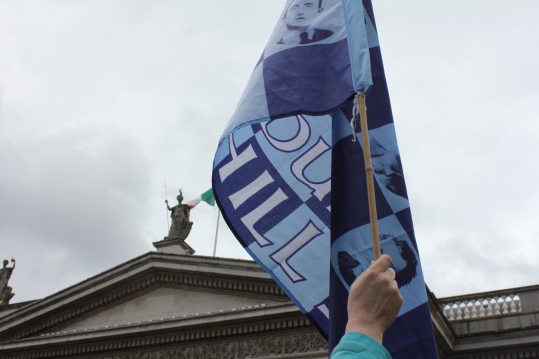Before arriving in Ireland, I admit I knew very little about the 1916 Easter Rising. While I explored the city, I learned so much and came away with an enriched knowledge of Irish history. I unintentionally visited Dublin during a historically significant week.
In 1916, Ireland was still under the rule of the British crown. A group of revolutionaries planned a daring and ultimately failed rebellion, attempting to claim Irish freedom. They presented the Proclamation of 1916, read allowed by Patrick Pearse outside the General Post Office. This document announced Ireland as a free republic, granting its citizens “religious and civil liberty, equal rights, and equal opportunities.” This included extending the right of voting to Irish women, something not allowed under British leadership.

The subsequent rebellion lasted for 6 days before the rebelling forces were overpowered and surrendered. Most of the leaders of the Irish forces were executed. With a high number of civilian casualties and many buildings in Dublin being destroyed, this was not a popular uprising. However, the subsequent reaction by the British government angered the people so much that they began thinking of the condemned leaders as martyrs, and eventually claimed Irish independence just a few years later in 1923.
While I wandered around Dublin, I had the opportunity to learn about the personal lives and motivations of the rebellion leaders. One such story that I found particularly wrenching was told during my tour of Kilmainham Gaol.

Chapel in Kilmainham Gaol where the Plunketts were wed.
The rebel leader Joseph Plunkett was being held here, awaiting execution. He was granted a last request, and was thus allowed to marry his love, Grace Gifford, just hours before his death. According to the animated tour guide, Plunkett and Gifford were married in the gaol’s chapel. He was brought forth in chains and they were not permitted to hold hands or share a kiss after their vows. She was then brought to his cell and they were allowed just 10 minutes together. The cell door was left open and a British soldier waited outside, counting down the minutes aloud. Shortly after, Plunkett was executed by firing squad.
Yet another tale out of Kilmainham gaol was that of James Connolly. Now, during the violent rebellion, Connolly was noted as bravely fighting alongside his men, as well as calling the shots from the GPO (General Post Office.) It was on one such excursion into the heat of things that he was wounded in the leg. This took place near Ha’Penny Bridge, actually very close to the hostel I stayed at. Connolly’s injury turned gangrenous. After the fighting he was brought to Dublin Castle for treatment. His trial was also held here due to his conditions. A few hours before his execution, he was allowed to be visited by his wife Lillie and his daughter Nora. He was then brought to Kilmainham. He was asked by Father Aloysius to grant forgiveness to the men of the firing squad, his executioners. Connolly is quoted as saying “I do, Father. I respect every man who does his duty.”
Connolly opted to stand, as his fellow condemned had. But his infection made it impossible and so he was placed in a chair. He slipped from it and was then tied to it. Subsequently the chair was knocked over by his slouching weight and thus it has been reported he was instead tied to a stretcher which was leaned upright. His death was gruesome and made him a legend.
These are just two stories of many, and I am sure I left plenty of interesting details out. But when the British forces began arresting civilians who had no part in the rebellion, and stories like these came to light, it sparked a change in the public opinion. What at first was an extremely unpopular rebellion eventually became a rallying cry. The leaders of it went from brash extremists to heroic patriots in the public eye. Thus it is celebrated as a turning point in the gaining of Ireland’s independence.

Walking around Dublin, pictures of the rebellion’s leaders are seen everywhere, in windows and billboards. The day I arrived to the city, a huge commemorative ceremony was taking place in front of the GPO. This included music and speeches by family members of the Easter Rising leaders and concluded with a parade to Glasnevin Cemetery where a renovated monument was being unveiled. Despite the chill in the air, I opted to follow the route to the cemetery. It was really amazing to start my trip off by witnessing this historic celebration, and set the tone for a very unique and informative visit.

